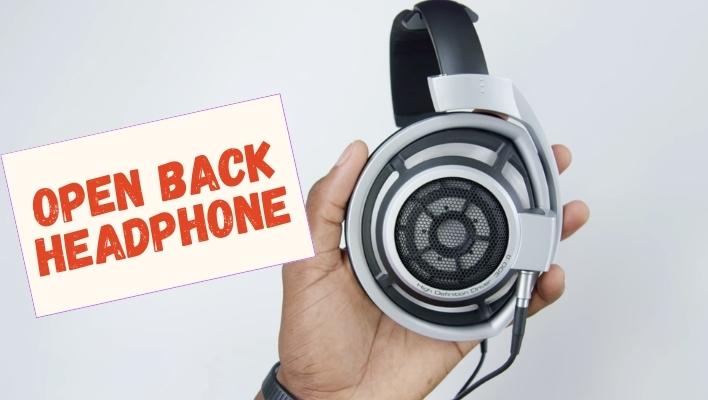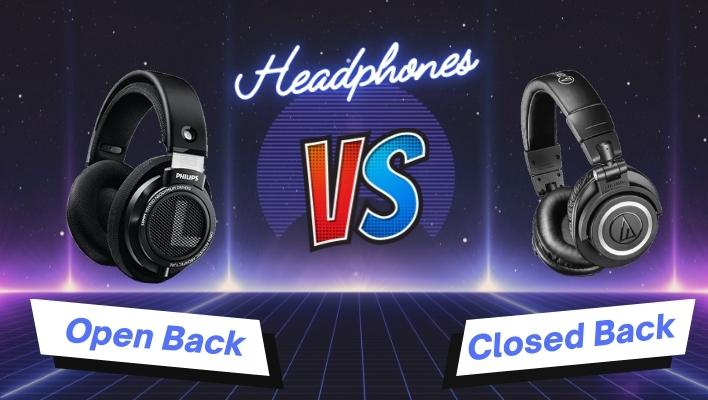Headphones draw sounds closer to us and make the world melodic, but they do more than this. Headphones are essential, from using headphones in some professions to entertainment or simply reducing environmental noise. Due to the importance of headphones in our day-to-day activities, we have questions and are curious to get information about headphones. For instance, open vs. closed back headphones have become a trendy topic online.
If you’re seeking the preferable headphone type between closed back and open back headphones, then read this article to the end. Here, we will examine closed back vs. open back headphones in terms of their differences in operation, advantages, and disadvantages.
What are Open Back Headphones?
Open-back headphones have an open-back design that allows air to flow through the rear of the earcups. The air can flow through the outward-facing earcups into your ear and your immediate environment. Therefore, the rear enclosure of open-back headphones that leads to low-frequency and resonance build-up is not a concern. Instead, the headphone enclosure minifies the isolation level between the user and the environment, producing a dynamic and wide soundstage that feels like you’re listening to speakers in a spacious room. Also, the air going through the open-back headphone makes it more suitable for long listening sessions because your ears get to breathe a bit.

Features of Open Back Headphone
1. Sound Leakages
You’ve probably heard people’s music while they were on headphones. Open-back headphones let out at least 30 decibels of your music to others because their design allows air the pass through the ear cups. Yet, while you may not fancy a situation where people around you can hear your music, you also get to listen to what people are saying. This means people around you should get your attention without having to wave at you or tap on your shoulder.
2. Lesser pressure
Pressure within the headphone is low because the sound flows in and out through the earcups. This prevents produced sound from getting trapped and gives the feel of an open sound. This advantage is that you can listen to sounds on the open-back headphones for extended periods without stressing your ears. Nonetheless, because the sound from the environment can flow into your headphone, you’re not isolated from the noise around you.
3. Audio Quality
The open design of most pricey open-back headphones allows them to produce a clear, more natural sound. However, this design feature causes open headphones to have a roll-off, making their bass output somewhat lacking and less powerful compared to other headphone models.
What are Closed Back Headphones?
Closed-back headphones have a closed-back design that seals air from flowing through the earcups. In other words, the air within the closed-back headphone does not escape but remains within the headphone. This prevents sound from escaping from the headphone into the surrounding. This implies that while your music might not sound as natural as on an open back pair, closed-back headphones will filter out much more outside noise. And this results in better sound isolation.

Features of Closed Back Headphones
1. Noise Isolation
The abundance of unwanted sounds is just about everywhere these days. These haphazard sounds hamper our listening and concentration. In this light, closed-back headphones help with noise and unwanted sounds. Although, noise-cancelling headphones are the best, closed-back headphones have quality noise cancellation. But to desirable extents, closed-back headphones isolate the noise of at least 30 decibels.
This is enough to get through the noisy interferences of a typical day. With low levels of noisy interference, you can listen to your music at a lesser volume. Even when your music is playing at a lower volume, the noise isolation of closed-back headphones works fine.
2. Fewer Noise Leaks
In addition to preventing noisy interference from reaching you, closed-back headphones prevent your sound from reaching out to your others. This means except if your music is loud, people around you will not get to hear from your headphones.
3. Audio Quality
Closed-back headphones have high audio quality because they prevent sounds from escaping. The main direction of sound in the closed-back headphone is towards the ears of the listener. Because the sound in the closed-back headphones does not escape, the headphone user listens to all the wave of the sound.

Differences Between Open-Back and Closed-Back Headphones
In picking the headphone that is best suited for you, you’ll need to understand the differences between the open-back and closed-back headphones. Closed-back headphones have advantages that cover the disadvantages of open-back headphones and vice–versa. Check the differences below:
1. Sound Control and Suitability
Open-back headphones leak sound and do not isolate noise, so they are not ideal for public spaces like the gym, offices, or commuting. On the other hand, closed-back headphones isolate noise and are suitable for use in public areas such as the subway, airplanes, and trains.
2. Suitability
Open-back headphones are also better suited for indoor spaces, say while at home, mixing and mastering beats and listening to high-resolution audio. Meanwhile, closed-back headphones are also ideal for recording and producing music because you can hear the sounds more intimately.
3. Handling
Open-back headphones require more cautious handling since they are fragile, and moisture can quickly get into them. On the flip side, closed-back headphones are not as delicate and are not easily affected by moisture.
4. Duration of Use
Open-back headphones are suitable for listening to audio for long durations due to their ability to let out pressure and ventilate the ears. In contrast, closed-back headphones are not ideal for listening to audio for long durations.
5. Cost
Closed-back headphones are often affordable, while open-back headphones are costlier.
Conclusion
The choice of a headphone depends on your needs and preferences. In most cases, it is not easy to pick one over the other, considering these headphones’ differences and unique features. Now that you know more about headphones, making a choice should be easier. Simply put, opt for a quality build-up headphone, and your sound experience will be unmatched.


